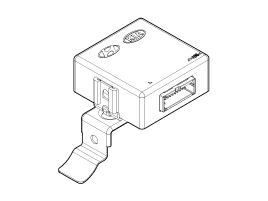Description

|
1. |
Mode
|
(1) |
Virgin State
| A. |
The receiver as a sole part is shipped in this
state. Replacement parts should therefore arrive in
this state.
|
| B. |
In this state, there is no Auto-Location, no sensor
wake-up, no sensor monitoring and no DTC monitoring..
|
| C. |
The state indicates that platform specific parameters
must be written to the receiver and that sensors are
un-learned.
|
|
|
(2) |
Normal State
| A. |
In order for tire inflation state and DTC monitoring
to occur, the receiver must be in this state.
|
| B. |
In this state, automatic sensor location is enabled.
|
|
|
|
2. |
Overview
| A. |
Sends LF command data to initiators.
|
| B. |
Controls sensor state:
Ignition on - Normal Delayed
Ignition off - Storage.
|
| E. |
Receives RF data from sensor.
|
| F. |
Uses sensor data to decide whether to turn on TREAD Lamp.
|
| G. |
Uses sensor information, distance traveled, background
noise levels, Auto-learn status, short circuit output status,
vehicle battery level, internal receiver states to determine
if there is a system or a vehicle fault.
|
|
Removal
Handle the sensor with care.
1.
Remove the tire. (Refer to "Tire Removal")
...
Circuit Diagram
Connector pin number
Pin NO.
Discription
Remark
1
-
2
-
...
See also:
Starter. Components and Components Location
Components
[REMY]
1. Front bracket
2. Stop ring
3. Stopper
4. Overrun clutch assembly
5. Internal gear assembly
6. Lever
7. Lever packing
8. Magnet s ...
Jack and tools
The jack, jack handle, and wheel lug nut wrench are stored in the luggage compartment.
Pull up the luggage box cover to reach this equipment.
(1) Jack handle (2) Jack (3) Wheel lug nut wrench
...
Variable Intake Solenoid (VIS) Valve. Description and Operation
Description
Variable Intake manifold Solenoid (VIS) valve is installed on the intake
manifold. The VIS valve controls the vacuum modulator which activates a valve
in the intake manifold. The ...
 Hyundai Sonata: TPMS Receiver. Description and Operation
Hyundai Sonata: TPMS Receiver. Description and Operation
 TPMS Sensor. Repair procedures
TPMS Sensor. Repair procedures TPMS Receiver. Schematic Diagrams
TPMS Receiver. Schematic Diagrams